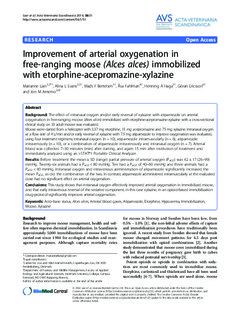Improvement of arterial oxygenation in free-ranging moose (Alces alces) immobilized with etorphine-acepromazine-xylazine
Lian, Marianne; Evans, Alina L.; Bertelsen, Mads F.; Fahlman, Åsa; Haga, Henning A.; Ericsson, Göran; Arnemo, Jon Martin
Journal article, Peer reviewed
Permanent lenke
http://hdl.handle.net/11250/218004Utgivelsesdato
2014-08-25Metadata
Vis full innførselSamlinger
Sammendrag
Background: The effect of intranasal oxygen and/or early reversal of xylazine with atipamezole on arterial
oxygenation in free-ranging moose (Alces alces) immobilized with etorphine-acepromazine-xylazine with a cross-sectional
clinical study on 33 adult moose was evaluated.
Moose were darted from a helicopter with 3.37 mg etorphine, 15 mg acepromazine and 75 mg xylazine. Intranasal oxygen
at a flow rate of 4 L/min and/or early reversal of xylazine with 7.5 mg atipamezole to improve oxygenation was evaluated,
using four treatment regimens; intranasal oxygen (n = 10), atipamezole intramuscularly (n = 6), atipamezole
intravenously (n = 10), or a combination of atipamezole intravenously and intranasal oxygen (n = 7). Arterial
blood was collected 7–30 minutes (min) after darting, and again 15 min after institution of treatment and
immediately analyzed using an i-STAT®1 Portable Clinical Analyzer.
Results: Before treatment the mean ± SD (range) partial pressure of arterial oxygen (PaO2) was 62 ± 17 (26–99)
mmHg. Twenty-six animals had a PaO2 < 80 mmHg. Ten had a PaO2 of 40–60 mmHg and three animals had a
PaO2 < 40 mmHg. Intranasal oxygen and intravenous administration of atipamezole significantly increased the
mean PaO2, as did the combination of the two. In contrast, atipamezole administered intramuscularly at the evaluated
dose had no significant effect on arterial oxygenation.
Conclusions: This study shows that intranasal oxygen effectively improved arterial oxygenation in immobilized moose,
and that early intravenous reversal of the sedative component, in this case xylazine, in an opioid-based immobilization
drug-protocol significantly improves arterial oxygenation.
